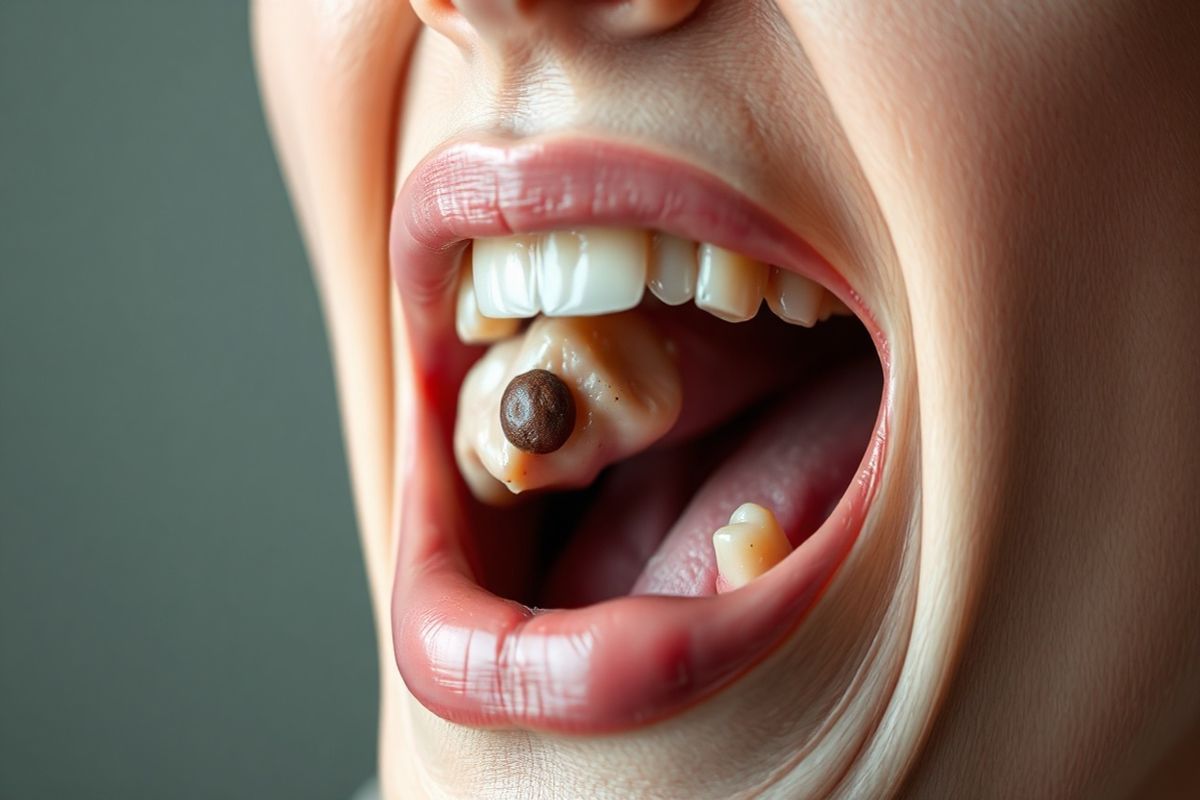Table of Contents
Understanding Hard Palate cancer: An Overview of This Rare Oral Cancer

Hard palate cancer is a rare form of oral cancer that develops on the hard palate—the bony section of the roof of the mouth. While this type of cancer accounts for only 1% to 5% of all oral cancers, it is critical to recognize its symptoms and seek early diagnosis to improve treatment outcomes (Cleveland Clinic, n.d.). The most common type of hard palate cancer is squamous cell carcinoma, which arises from the flat cells lining the mouth and is often associated with risk factors such as tobacco and alcohol use, as well as poor dental hygiene (MD Anderson, n.d.).
The hard palate itself is a vital anatomical structure, serving as a barrier between the mouth and nasal cavity. When cancerous lesions form in this area, they can lead to significant complications, including invasion into adjacent tissues, pain, and functional impairments affecting speech and swallowing (Cleveland Clinic, n.d.).
Key Symptoms to Watch For: Early Detection of Hard Palate Cancer

Recognizing the symptoms of hard palate cancer is essential for early detection and effective treatment. Symptoms may vary depending on the cancer’s stage, and they include:
-
Stage I Symptoms:
- A persistent ulcer or sore in the mouth that does not heal.
- White patches, also known as leukoplakia, or red patches known as erythroplakia.
- Changes in texture or color in the oral cavity.
-
Stage II and III Symptoms:
- Increased pain in the mouth that is persistent.
- Numbness or a loss of sensation in the jaw, lips, or tongue.
- Difficulty swallowing, slurred speech, or noticeable changes in speech.
- Loose teeth or dentures that no longer fit properly.
-
Stage IV Symptoms:
- Severe pain in the mouth or jaw.
- Swelling or lumps in the neck or jaw.
- Trismus, or the inability to open the mouth fully, due to muscle involvement or nerve invasion (Amit, n.d.).
It is crucial to consult a healthcare provider if any of these symptoms persist for more than two weeks without improvement. Early detection often leads to better prognoses and may reduce the need for aggressive treatments such as chemotherapy or radiation (Amit, n.d.).
Unraveling the Causes: Risk Factors Linked to Hard Palate Cancer
Several risk factors have been associated with hard palate cancer, most notably the use of tobacco and excessive alcohol consumption. Tobacco in any form—cigarettes, pipes, cigars, and smokeless tobacco—significantly increases the risk of developing oral cancers, including hard palate cancer (Healthline, n.d.). Additionally, heavy alcohol consumption has been identified as a contributing factor, particularly when combined with tobacco use, as this combination greatly amplifies the risk (Cleveland Clinic, n.d.).
Other potential risk factors include:
- Poor Oral Hygiene: Neglecting dental care can lead to chronic inflammation and irritation in the oral cavity, increasing susceptibility to cancer (Cleveland Clinic, n.d.).
- Human Papillomavirus (HPV) Infection: Certain strains of HPV are known to be associated with various head and neck cancers (National Institute of Dental and Craniofacial Research, n.d.).
- Age and Gender: The likelihood of developing hard palate cancer increases with age, and it tends to affect more men than women (Cleveland Clinic, n.d.).
- Chronic Irritation: Conditions such as ill-fitting dentures or dental appliances can cause chronic irritation and may contribute to cancer risk over time (Healthline, n.d.).
Understanding these risk factors is vital for preventive measures and early intervention strategies.
Diagnostic Approaches: How Hard Palate Cancer is Identified
Diagnosing hard palate cancer involves a combination of clinical evaluations and diagnostic testing. The process typically includes:
-
Physical Examination: A thorough examination of the mouth, including visual inspection and palpation of the hard palate and surrounding tissues, is conducted by a healthcare professional. Dentists often play a crucial role in early detection during routine checkups (MD Anderson, n.d.).
-
Biopsy: A biopsy is the definitive method for diagnosing hard palate cancer. This procedure involves the removal of a small tissue sample from the suspected tumor, which is then examined microscopically for the presence of cancer cells (Cleveland Clinic, n.d.).
-
Imaging Studies: Imaging techniques such as CT scans and MRIs are utilized to assess the size of the tumor, its depth of invasion, and potential metastasis to lymph nodes or other body parts. These images can provide critical information for staging the cancer and developing a treatment plan (Cleveland Clinic, n.d.).
-
Staging: Hard palate cancer is categorized into stages (I-IV), which describe the extent of tumor growth and spread. Stage I tumors are localized, while Stage IV tumors indicate significant spread to nearby lymph nodes or distant sites (Healthline, n.d.).
Comprehensive Treatment Strategies: Navigating Options for Hard Palate Cancer and Oral Cancer Treatment
The treatment of hard palate cancer varies based on the stage of cancer, overall health of the patient, and specific tumor characteristics. The main treatment modalities include:
1. Surgery
-
Tumor Resection: Surgical removal of the tumor is often the first line of treatment. In early-stage cancers, complete excision may be sufficient to achieve a cure (Healthline, n.d.). In cases where the tumor is larger or has invaded surrounding tissues, more extensive surgery, such as a maxillectomy (removal of the hard palate), may be necessary.
-
Reconstructive Surgery: Following extensive tumor resection, reconstructive surgery may be needed to restore the appearance and function of the mouth. This can involve using tissue from other parts of the body or creating a prosthetic (MD Anderson, n.d.).
2. Radiation Therapy
Radiation therapy is frequently used as an adjuvant treatment to eliminate residual cancer cells post-surgery. It may also be employed as a primary treatment for patients who are not candidates for surgery due to health complications (Cleveland Clinic, n.d.).
3. Chemotherapy
Chemotherapy may be recommended for more advanced stages of hard palate cancer, especially if there is a risk of metastasis (Healthline, n.d.). It is often used in conjunction with radiation therapy in a strategy known as chemoradiotherapy, which can enhance the effectiveness of treatment by attacking the cancer cells on multiple fronts (Cancer Research UK, n.d.).
4. Immunotherapy
In select cases, immunotherapy may be an option, especially for tumors that exhibit specific genetic markers. This treatment aims to bolster the body’s immune response against cancer cells (MD Anderson, n.d.).
5. Clinical Trials
Participating in clinical trials may provide access to cutting-edge treatments not yet widely available. These trials can offer patients the opportunity to receive innovative therapies that may improve outcomes (MD Anderson, n.d.).
In summary, the treatment approach for hard palate cancer is multifaceted and tailored to the individual patient, emphasizing the importance of a comprehensive care team involving oncologists, surgeons, radiation therapists, and support staff.
FAQ
What are the early signs of hard palate cancer?
Early signs may include non-healing ulcers or sores on the hard palate, persistent white or red patches, and changes in speech or swallowing difficulties.
How is hard palate cancer diagnosed?
Diagnosis typically involves a physical examination, biopsy of any suspicious lesions, and imaging tests like CT or MRI to assess the extent of the disease.
What treatments are available for hard palate cancer?
Treatment options include surgery, radiation therapy, chemotherapy, immunotherapy, and participation in clinical trials.
Is hard palate cancer common?
No, hard palate cancer is considered rare, accounting for only 1% to 5% of all oral cancers.
What are the risk factors for developing hard palate cancer?
Key risk factors include tobacco and alcohol use, poor oral hygiene, HPV infection, chronic irritation, and age.
References
- Amit, M. (n.d.). Oral cancer symptoms by stage. Retrieved from https://www.mdanderson.org/cancerwise/oral-cancer-symptoms-by-stage.h00-159699123.html
- Cleveland Clinic. (n.d.). Hard Palate Cancer: Symptoms, Causes, Diagnosis, and Treatment. Retrieved from https://my.clevelandclinic.org/health/diseases/24789-hard-palate-cancer
- Healthline. (n.d.). Hard Palate Cancer. Retrieved from https://www.healthline.com/health/hard-palate-cancer
- MD Anderson. (n.d.). Cancer of the hard palate: 8 things to know. Retrieved from https://www.mdanderson.org/cancerwise/cancer-of-the-hard-palate--8-things-to-know.h00-159616278.html
- National Institute of Dental and Craniofacial Research. (n.d.). Oral Cancer. Retrieved from https://www.nidcr.nih.gov/health-info/oral-cancer
- Cancer Research UK. (n.d.). Treatment for tongue cancer. Retrieved from https://www.cancerresearchuk.org/about-cancer/mouth-cancer/stages-types-grades/tongue-cancer/treatment
- University of Maryland Greenebaum Comprehensive Cancer Center. (n.d.). Oral Cancer. Retrieved from https://www.umms.org/umgccc/cancer-services/cancer-types/head-neck/oral











